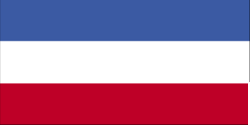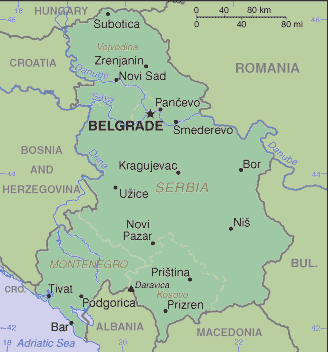Traveling Luck for Serbia And Montenegro. Serbia And Montenegro, Europe
is located in Southeastern Europe, bordering the Adriatic Sea, between Albania and Bosnia and Herzegovina.
Land in is extremely varied; to the north, rich fertile plains; to the east, limestone ranges and basins; to the southeast, ancient mountains and hills; to the southwest, extremely high shoreline with no islands off the coast.
Serbian; Montenegrin land covers an area of 102350 square kilometers which is slightly smaller than Kentucky
 Serbian; Montenegrin national flag (Flag of Serbia And Montenegro)
Serbian; Montenegrin national flag (Flag of Serbia And Montenegro)
As for the Serbian; Montenegrin climate; in the north, continental climate (cold winters and hot, humid summers with well distributed rainfall); central portion, continental and Mediterranean climate; to the south, Adriatic climate along the coast, hot, dry summers and autumns and relatively cold winters with heavy snowfall inland.
Serb(s); Montenegrin(s) speak Serbian 95%, Albanian 5%.
 Serbian; Montenegrin map
Serbian; Montenegrin map
Regions of Serbia And Montenegro
The Kingdom of Serbs, Croats, and Slovenes was formed in 1918; its name was changed to Yugoslavia in 1929. Occupation by Nazi Germany in 1941 was resisted by various paramilitary bands that fought each other as well as the invaders. The group headed by Josip TITO took full control of Yugoslavia upon German expulsion in 1945. Although Communist, his new government and its successors (he died in 1980) managed to steer their own path between the Warsaw Pact nations and the West for the next four and a half decades. In the early 1990s, post-TITO Yugoslavia began to unravel along ethnic lines: Slovenia, Croatia, Macedonia, and Bosnia and Herzegovina were recognized as independent states in 1992. The remaining republics of Serbia and Montenegro declared a new Federal Republic of Yugoslavia (FRY) in April 1992 and, under President Slobodan MILOSEVIC, Serbia led various military intervention efforts to unite ethnic Serbs in neighboring republics into a "Greater Serbia." These actions led to Yugoslavia being ousted from the UN in 1992, but Serbia continued its campaign until signing the Dayton Peace Accords in 1995. In 1998-99, massive expulsions by FRY forces and Serb paramilitaries of ethnic Albanians living in Kosovo provoked an international response, including the NATO bombing of Belgrade and the stationing of a NATO-led force (KFOR), in Kosovo. Federal elections in the fall of 2000, brought about the ouster of MILOSEVIC and installed Vojislav KOSTUNICA as president. The arrest of MILOSEVIC in 2001 allowed for his subsequent transfer to the International Criminal Tribunal for the Former Yugoslavia in The Hague to be tried for crimes against humanity. In 2001, the country's suspension from the UN was lifted, and it was once more accepted into UN organizations under the name of the Federal Republic of Yugoslavia. Kosovo has been governed by the UN Interim Administration Mission in Kosovo (UNMIK) since June 1999, under the authority of UN Security Council Resolution 1244, pending a determination by the international community of its future status. In 2002, the Serbian and Montenegrin components of Yugoslavia began negotiations to forge a looser relationship. In February 2003 lawmakers restructured the country into a loose federation of two republics called Serbia and Montenegro. The Constitutional Charter of Serbia and Montenegro included a provision that allowed either republic to hold a referendum after three years that would allow for their independence from the state union. In the spring of 2006, Montenegro took advantage of the provision to undertake a successful independence vote enabling it to secede on 3 June. Two days later, Serbia declared that it was the successor state to the union of Serbia and Montenegro.
MILOSEVIC-era mismanagement of the economy, an extended period of economic sanctions, and the damage to Yugoslavia's infrastructure and industry during the NATO airstrikes in 1999 left the economy only half the size it was in 1990. After the ousting of former Federal Yugoslav President MILOSEVIC in October 2000, the Democratic Opposition of Serbia (DOS) coalition government implemented stabilization measures and embarked on an aggressive market reform program. After renewing its membership in the IMF in December 2000, a down-sized Yugoslavia continued to reintegrate into the international community by rejoining the World Bank (IBRD) and the European Bank for Reconstruction and Development (EBRD). A World Bank-European Commission sponsored Donors' Conference held in June 2001 raised $1.3 billion for economic restructuring. An agreement rescheduling the country's $4.5 billion Paris Club government debts was concluded in November 2001 - it wrote off 66% of the debt - and the London Club of private creditors forgave $1.7 billion of debt, just over half the total owed, in July 2004. The smaller republic of Montenegro severed its economy from federal control and from Serbia during the MILOSEVIC era and continues to maintain its own central bank, uses the euro instead of the Yugoslav dinar as official currency, collects customs tariffs, and manages its own budget. Kosovo's economy continues to transition to a market-based system, and is largely dependent on the international community and the diaspora for financial and technical assistance. The euro and the Yugoslav dinar are both accepted currencies in Kosovo. While maintaining ultimate oversight, UNMIK continues to work with the EU and Kosovo's local provisional government to accelerate economic growth, lower unemployment, and attract foreign investment to help Kosovo integrate into regional economic structures. The complexity of Serbia and Montenegro political relationships, slow progress in privatization, legal uncertainty over property rights, scarcity of foreign-investment, and a substantial foreign trade deficit are holding back the economy. Arrangements with the IMF, especially requirements for fiscal discipline, are an important element in policy formation. Severe unemployment remains a key political and economic problem for this entire region.
Serbian; Montenegrin natural resources include oil, gas, coal, iron ore, bauxite, copper, lead, zinc, antimony, chromite, nickel, gold, silver, magnesium, pyrite, limestone, marble, salt, hydropower, arable land
controls one of the major land routes from Western Europe to Turkey and the Near East; strategic location along the Adriatic coast
Serbian; Montenegrin religion is Orthodox 65%, Muslim 19%, Roman Catholic 4%, Protestant 1%, other 11%.
Natural hazards in include destructive earthquakes.

 Search
Search